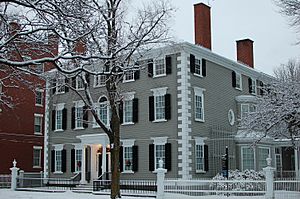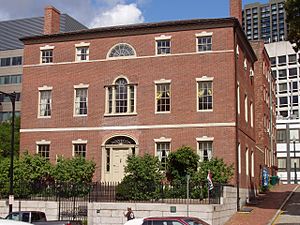Historic New England facts for kids
Historic New England is a special non-profit group that works to save old buildings, landscapes, and objects in New England. It's the oldest and largest organization of its kind in the United States. Based in Boston, Massachusetts, it helps people learn about the past.
This group owns and takes care of many historic sites and museums across New England, except for Vermont. Every year, over 198,000 people visit their sites or join their programs. About 48,000 of these are students and young people learning about New England's history. Historic New England acts like a museum of cultural history. It collects items from the 1600s to today. By doing this, they keep history alive and help everyone understand and enjoy New England life more. They also show why it's important to protect these historical treasures.
Contents
How Historic New England Started
The organization was founded in 1910 by William Sumner Appleton Jr. It was first called the Society for the Preservation of New England Antiquities (SPNEA). Appleton worried that "our New England antiquities are fast disappearing." He wanted to create a group whose main goal was to save these important historical items.
By 1920, the museum's goal was to "preserve and illustrate the life of New Englanders." This includes stories about families, immigrants, school routines, servants' jobs, and even enslaved Africans. It also covers the work of builders and furniture makers. The first meeting happened at the Boston home of Mary Lee Ware, a kind helper of Harvard University.
What They Collect and Do
When the group started in 1910, they collected 19 items. Appleton believed everything, from simple everyday things like soap to amazing pieces of furniture, was worth saving. Today, Historic New England has a huge collection.
As a complete heritage organization, they do many things:
- They care for historic properties and landscapes.
- They help protect historic places by holding special agreements called preservation easements.
- They collect and show old objects.
- They run a library and archive with old documents.
- They research and publish books and a magazine called Historic New England.
- They offer educational programs for both kids and adults.
Their main goal is to "serve the public by preserving and presenting New England heritage." They focus on homes, collections, and stories from New England.
Leaders of the Organization
After William Sumner Appleton, several people led the organization. These included Bertram K. Little, Abbott Lowell Cummings, and Nancy R. Coolidge. Later, the leader's title changed to President. Jane C. Nylander was the first to hold this title. Carl R. Nold followed her. Since 2020, Vin Cipolla has been the President and CEO of Historic New England.
The organization also used to have a special center for architectural conservation. This center helped create new ways to save old buildings. A researcher named Morgan W. Phillips even came up with the term "architectural conservation."
Historic Properties They Own

Historic New England currently owns and manages 37 house museums. They also care for 1,284 acres of farmland and other landscapes. These properties are spread across five New England states. They show nearly 400 years of different building styles.
The organization also has a huge collection of over 100,000 historical and beautiful objects. This is the largest collection of New England art and artifacts in the country. They also keep more than one million items that tell the story of New England's buildings and cultural history. These include photographs, drawings, books, and old papers.
Accessing Collections and Storage
In 2010, the Collections Access Project started online. This project lets people look up information about many of their collections on the internet.
Their main Collections and Conservation Center is in Haverhill, Massachusetts. It's in an old shoe factory building. This center is not open to the public. However, it makes sure the collections are properly cared for. It also allows curators, students, and scholars to access information about the collections. Other museums also rent space here to store their own collections.
Historic New England also owns the Plum Island Airport. This is a small public airport in Newburyport, Massachusetts. It has been used for flying since 1910. The airport is on the land of the historic Spencer-Peirce-Little Farm. This farm was given to the organization in 1971 and became a museum in 1986.
Traveling Exhibitions
Historic New England has a program that sends its collections and research to other museums. This allows more people to see and learn from their items.
Some past exhibitions have included:
- America's Kitchens: This show was at the New Hampshire Historical Society in 2009.
- Drawing Toward Home: This exhibition of architectural drawings opened at the Boston University Art Gallery in 2009. It then traveled to the National Building Museum in Washington, D.C. in 2010.
- The Preservation Movement Then and Now: This special exhibition celebrated the organization's 100th birthday. It appeared in all six New England states from late 2009 through 2013.
You can also find online exhibitions. These include Jewelry at Historic New England, The Preservation Movement Then and Now, From Dairy to Doorstep: Milk Delivery in New England, 1860-1960, and New England Photographs of Verner Reed.
Protecting Properties with Easements
Since the early 1980s, Historic New England has had a special program called a conservation easement program. Through this program, they hold agreements on over 120 privately owned properties in New England. These agreements help make sure that the important historical parts of these homes are protected.
This program is seen as a great example for protecting buildings that are still used and owned by private people. About one-third of the properties in this program were once owned by Historic New England. They were sold back to private owners with rules to protect them forever. Other properties joined the program when their owners donated these protection agreements to the organization. Money is also given to help pay for checking and enforcing these agreements. A full-time team works to make sure the rules are followed.
Membership Programs
Historic New England offers different membership programs for people who want to support their work or learn more.
- Historic Homeowner program: This program is for anyone who owns an old house, even homes from the mid-20th century. Members get two free talks with experts. They can ask about things like historic paint colors, window repair, roofing, or old wallpaper.
- Gardens and Landscapes: This program focuses on historic gardens and outdoor spaces.
- Young Friends program: This program is for young adults.
- Appleton Circle: This is a higher-level membership for people who give a lot of support to the organization's programs.
How the Organization is Run
Historic New England is a 501(c)(3) tax-exempt non-profit organization. This means it's a charity and doesn't have to pay certain taxes. It is guided by a board of 15 trustees.
Museum Properties Open to the Public
The following properties are open for visitors. Most are open during the warmer months, usually from June to mid-October. Many are only open on certain days or weekends. Some very old or delicate properties are open only a few days a year. The grounds of some properties, like the Lyman Estate and the Langdon House, can be rented for private events.
- Connecticut: Roseland Cottage.
- Maine: Bowman House, Castle Tucker, Hamilton House, Sarah Orne Jewett House, Marrett House, Nickels-Sortwell House, and Sayward-Wheeler House.
- Massachusetts: Beauport, Sleeper-McCann House, Boardman House, Browne House, Codman House, Coffin House, Cogswell's Grant, Cooper-Frost-Austin House, Winslow Crocker House, Dole-Little House, Eustis Estate, Gedney House, Gropius House, Lyman Estate, Merwin House, Harrison Gray Otis House, Pierce House, Josiah Quincy House, Rocky Hill Meeting House, Spencer-Peirce-Little Farm, Stephen Phillips House and Swett-Ilsley House.
- New Hampshire: Barrett House, Gilman Garrison House, Richard Jackson House, Governor John Langdon House, and Rundlet-May House.
- Rhode Island: Arnold House, Casey Farm, Clemence-Irons House, Watson Farm.
See also
- The Trustees of Reservations
- National Trust for Historic Preservation
- List of historic houses in Massachusetts
- List of historical societies in Massachusetts



